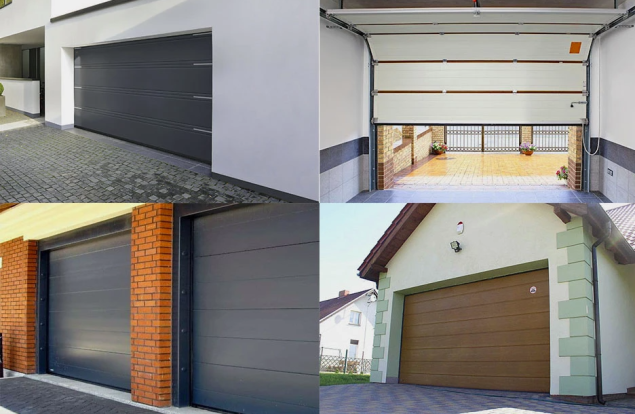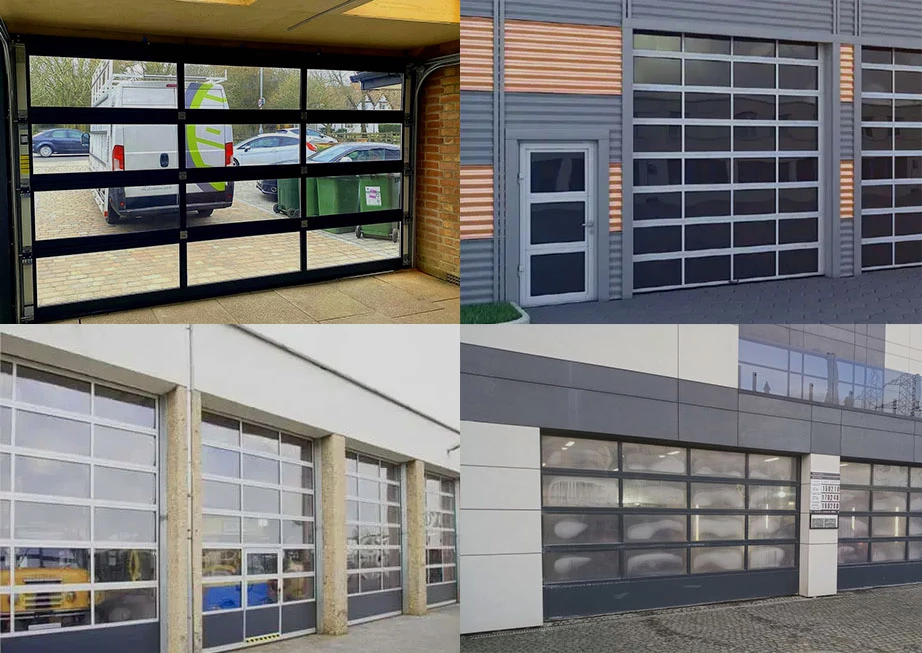305
How to choose the ideal garage door - 6 key criteria
The ideal garage door is the one that best suits your individual needs and preferences!
Today, the market offers a wide range of sectional garage doors covering different price categories. However, evaluating them only by price is the wrong approach. When contacting different companies with a request for a calculation, you may be offered significantly different prices, even if the parameters are the same. Let's find out why this happens.

Types of garage doors
First of all, it is important to distinguish three main types of garage doors, each of which has its own unique characteristics.
It becomes clear that metal gates are a more budget-friendly option, while sectional gates are often more expensive solutions.
Energy efficiency
It is important that metal gates are usually characterized by low thermal protection, as they consist of a single sheet of metal with minimal insulation, limiting heat retention. Roller shutters, with relatively low slat thickness (maximum 14 mm), are also not an optimal choice for creating a warm garage.
Sectional doors offer different section thicknesses — 40 and 45 mm, providing better energy-saving characteristics, which is especially valuable when using the garage as a workshop, office or music studio.
Management systems
Opening the garage door is possible manually or using the remote control, if automation is installed. The average cost of garage door automation is 140-300 euros, adding approximately 15-25% to the total cost of the door.
The choice between automated and manual gates depends on the level of comfort you are used to and your willingness to pay extra.

Anti-corrosion protection
When deciding which garage door to buy, it is important to consider the operating conditions. Metal gates are more prone to corrosion, especially in regions with high humidity or near the sea. Roller shutters made of aluminum can also corrode and are not recommended for use in car wash environments.
Sectional gates made of polyurethane foam and galvanized steel provide high resistance to corrosion. Components and mechanisms can also be made of galvanized or stainless steel, providing additional protection.
Polymer coatings on mechanisms strengthen this protection, making sectional doors a reliable choice for various operating conditions.
Intensity of use
At home, garage doors are usually opened 2-4 times a day, which is suitable for all types of doors - metal, roller and sectional. However, if we are talking about an industrial object with a high intensity of opening, the most reliable design is required. Classic metal gates cope with this task, but manual control may be required.
Roller gates are not always suitable for intensive use, so they may not be able to cope with the increased load.
Industrial sectional doors are an ideal solution for such facilities, providing reliability and the possibility of automation.
Light transmission capacity
In the domestic segment of garage doors, attention is often not paid to light transmission properties. In industrial settings, especially for car showrooms, the light transmission capacity of the gate can be a key factor, as the gate acts as a shop window.
Panoramic sectional doors are the optimal solution in this case, providing high transparency and aesthetic effect.

Let's summarize
This in-depth look at different garage doors is designed to help you understand that choosing one shouldn't just be based on price. Each parameter, such as material, availability of automation, anti-corrosion protection, and even color affects the final cost. Therefore, asking for a calculation of the cheapest option may lead to insufficient consideration of your needs and expectations.
Before buying a garage door, it is recommended to make a list of requirements by answering the following questions:
Considering these factors, you will be able to more accurately choose a garage door that meets your requirements and provides maximum comfort and functionality.
Today, the market offers a wide range of sectional garage doors covering different price categories. However, evaluating them only by price is the wrong approach. When contacting different companies with a request for a calculation, you may be offered significantly different prices, even if the parameters are the same. Let's find out why this happens.

Types of garage doors
First of all, it is important to distinguish three main types of garage doors, each of which has its own unique characteristics.
- Classic gate
The first type of garage door is represented by the classics - metal hinged structures. Until recently, metal gates were the only option available. These are two metal sheets, suspended on hinges, with a central lock. - Sectional gates
The second type is a sectional gate. Their canvas consists of several sections, usually 5-6 in the domestic version and 8-14 in the industrial version. They rise up along the guides and then get under the ceiling. - Roller gates
The third type is a roller shutter gate consisting of narrow strips, or shutters. The principle of operation is similar to sectional gates, but instead of rising under the ceiling, they are twisted into a drum.
It becomes clear that metal gates are a more budget-friendly option, while sectional gates are often more expensive solutions.
Energy efficiency
It is important that metal gates are usually characterized by low thermal protection, as they consist of a single sheet of metal with minimal insulation, limiting heat retention. Roller shutters, with relatively low slat thickness (maximum 14 mm), are also not an optimal choice for creating a warm garage.
Sectional doors offer different section thicknesses — 40 and 45 mm, providing better energy-saving characteristics, which is especially valuable when using the garage as a workshop, office or music studio.
Management systems
Opening the garage door is possible manually or using the remote control, if automation is installed. The average cost of garage door automation is 140-300 euros, adding approximately 15-25% to the total cost of the door.
The choice between automated and manual gates depends on the level of comfort you are used to and your willingness to pay extra.

Anti-corrosion protection
When deciding which garage door to buy, it is important to consider the operating conditions. Metal gates are more prone to corrosion, especially in regions with high humidity or near the sea. Roller shutters made of aluminum can also corrode and are not recommended for use in car wash environments.
Sectional gates made of polyurethane foam and galvanized steel provide high resistance to corrosion. Components and mechanisms can also be made of galvanized or stainless steel, providing additional protection.
Polymer coatings on mechanisms strengthen this protection, making sectional doors a reliable choice for various operating conditions.
Intensity of use
At home, garage doors are usually opened 2-4 times a day, which is suitable for all types of doors - metal, roller and sectional. However, if we are talking about an industrial object with a high intensity of opening, the most reliable design is required. Classic metal gates cope with this task, but manual control may be required.
Roller gates are not always suitable for intensive use, so they may not be able to cope with the increased load.
Industrial sectional doors are an ideal solution for such facilities, providing reliability and the possibility of automation.
Light transmission capacity
In the domestic segment of garage doors, attention is often not paid to light transmission properties. In industrial settings, especially for car showrooms, the light transmission capacity of the gate can be a key factor, as the gate acts as a shop window.
Panoramic sectional doors are the optimal solution in this case, providing high transparency and aesthetic effect.

Let's summarize
This in-depth look at different garage doors is designed to help you understand that choosing one shouldn't just be based on price. Each parameter, such as material, availability of automation, anti-corrosion protection, and even color affects the final cost. Therefore, asking for a calculation of the cheapest option may lead to insufficient consideration of your needs and expectations.
Before buying a garage door, it is recommended to make a list of requirements by answering the following questions:
- Where will the gate be installed?
- What is the intensity of discoveries?
- Is additional corrosion protection required?
- Do the gates open manually or automatically?
- Warm or cold garage?
- How many cars are in the garage?
- Is there a separate entrance to the garage and is a gate required?
- Is jacking protection required?
Considering these factors, you will be able to more accurately choose a garage door that meets your requirements and provides maximum comfort and functionality.
Who were the parents of Pugacheva, whom she entrusted the upbringing of her daughter Kristina
Pray for Parents: When the First Universal (Meatless) Parental Saturday in 2024























